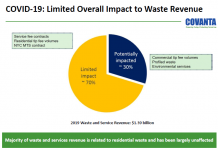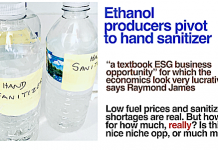Jim Lane
Eight technologies, seven public stocks – who’s adopting what, who’s in the lead?
Perhaps you have written off ethanol as a bum investment.
That’s understandable. Though, as a general rule, all acts of mind-closing should be made while chanting Michael Dell’s mantra from 1997, writing off Apple as a bum investment.
It’s a good chant, you could try it. Here’s how it goes.
“What would I do?” Hari Rama.
“I’d shut it down.” Rama Krishna.
“And give the money back”. Krishna Rama.
“To the shareholders.” Rama Rama.
Missing the biggest gold rush. Krishna Hari.
In market history. Hari Krishna.”
If chanting is not your thing, perhaps you and I can visit a while on the 8 Upsides of the New Ethanol.
The technologies out there are five in number. They are all in commercial deployment now, though some are at the capacity-construction stage. Some of them vary the feedstock, some vary the products produced. What they share is an ability to be co-located, bolted-on, or retrofitted into existing ethanol plants.
The upside varies in character. In some cases, there are cost reductions. In others, higher volumes. Some offer higher-priced product opportunities. Some allow access to higher-value renewable fuel credits (called RINs) that are used under the Renewable Fuel Standard to encourage the development of advanced, non-food biofuels.
We’ve looked at them as technologies, here in “7 Bleeding Edge Technologies unlocking Mighty Value in the First-gen Ethanol fleet“, and here in “The (Next) Next-Gen Cellulosic Biofuels“, and here in “7 Paths of the New Agriculture“.
Here, in BioInvest Digest, we look strictly at the investment aspect – what does it mean, when, for whom, and always, always how much.
Here’s the investment set – Aventine Renewables (AVRW), Pacific Ethanol (PEIX), Green Plains Renewable Energy (GPRE), Gevo (GEVO), Biofuel Energy (BIOF), BlueFire Renewables (BFRE), and Aemetis (AMTX).
Now, the technologies.
1. Feedstock switching. Sorghum as the new corn?
What it is: Switching from corn and natural gas to grain sorghum and biogas.
As we saw in “The New Milo-naires: Corn, Milo and the Biofuels Market’s Invisible Hand”. Aemetis (AMTX:OTC) operates a 60 mgy corn ethanol plant which imported milo from Argentina in Q4 2012 at a cost savings of about $0.90 per bushel under corn. They require approximately 22 million bushels per year at capacity, so the milo savings are more than $18 million per year. Add $18 million to the $24 million per year AB RIN’s, subtract about $8 million for the increased cost of biogas, and the net increase in cash flow is about $34 million per year for the 60 mgy (former) corn ethanol plant operated by Aemetis.
Who makes it: The milo is being imported from Argentina.
The upside: $0.56 per gallon, according to Aemetis.
Who’s using: Aemetis (AMTX).
2. Advanced extraction and yield technologies.
What it is: Pacific Ethanol is installing Edeniq technology at Pacific Ethanol’s Stockton, California ethanol plant. Pacific Ethanol will install Edeniq’s proprietary Cellunators™ to boost ethanol yields, and will also deploy Edeniq’s patented OilPlus™ corn oil extraction process to increase corn oil recovery.
Who makes it: EdeniQ
The upside: Not yet made public.
Who’s using: Pacific Ethanol (PEIX).
3. Advanced enzymes.
What it is: Our 2012 Biofuels Digest Yield Improvement Award went to Mascoma and Lallemand’s TransFerm enzymes. It’s a bioengineered drop-in substitute for conventional fermenting yeast that lowers costs for corn ethanol producers by alleviating the need to purchase a significant amount of the expensive enzymes currently used in corn ethanol production.
Who makes it: Mascoma and Lallemand.
The upside: 3.4% increase in ethanol yield, or 7.6 cents per gallon.
4. Enzymes in corn.
What it is: In October, we reported that Syngenta and Plymouth Energy signed an agreement to use Enogen trait technology starting in fall 2013. Syngenta states that when using Enogen trait technology there is no need to use liquid alpha amylase enzyme for dry grind ethanol production.
Over in Massachusetts, Agrivida has been working hard too. “Agrivida has created a proprietary INzyme molecular engineering technology that allows the renewable chemicals, fuels and other industries to grow a substrate of non-food energy crops that contain dormant enzymes.
Who makes it: Syngenta, Agrivida
The upside: $70 cents per gallon, according to Agrivida, on cellulosic ethanol production cost.
Who’s using: Plymouth Energy among others have adopted Enogen.
5. Algae co-location and production.
What it is: Our 2012 Industrial Symbiosis Award went to Green Plains Renewable Energy and BioProcess Algae for the BioProcess Algae project as it advances from a small pilot system to a 5-acre demonstration including all components systems that lead from CO2 capture through algae growth, harvest, and extraction.
Who makes it: BioProcess Algae.
The upside: Could be more than $2.60 per gallon in revenue- early days on the cost to get there. That’s the upside with high-value algae made from waste CO2.
Who’s using: Green Plains Renewable Energy (GPRE).
6. Switchover to biobutanol.
What it is: Take the same corn ethanol feedstock stream, add a relatively low-impact unit for biobutanol production, and produce a $4 molecule instead of a $2 molecule.
Who makes it: Gevo (GEVO), Butamax
The upside: Could be $1.60 per gallon of revenue upside, long term, based on $2 more per gallon for the molecule and 20% drop in production yield.
Who’s using: 10+ plants in early adopter programs. Gevo’s plant in Luverne, MN has the technology installed but is awaiting an upgrade.
7. Cellulosic Ethanol add-on
What it is: Take a 100 million gallon traditional ethanol plant in Emmetsburg. Start bringing in the corn stover as well as the corn kernels – add-on some highly cool enzymatic hydrolysis technologies and – voila – you have 25 million gallons of bolt-on production, same grower base, same location.
Who makes it: POET-DSM
The upside: $0.56 per installed gallon of capacity, based on boosting capacity by 25 percent. Costs to get there – that’s not yet stablized.
Who’s using: POET-DSM
8. Cut-over to cellulosic sugars.
What it is: A hub-and-spoke process to convert locally avai
lable cellulosic, non-food biomass, such as crop residues, energy crops, and woody biomass into highly fermentable sugar, which an ethanol producer will ferment into ethanol.
Who makes it: Sweetwater (in this model), but also Renmatix, BlueFire (BFRE), Comet, and Proterro among others,
The upside: In the Sweetwater model, as much as $0.55 per gallon in upside based on reducing feedstocks costs by as much as 15% over last-bushel of corn and a $0.40 gain in RIN value.
Who’s using: Front Range Energy, Ace Ethanol.
Disclosure: None.
Jim Lane is editor and publisher of Biofuels Digest and BioInvest Digest where this article was originally published. Biofuels Digest is the most widely read Biofuels daily read by 14,000+ organizations. Subscribe here.








